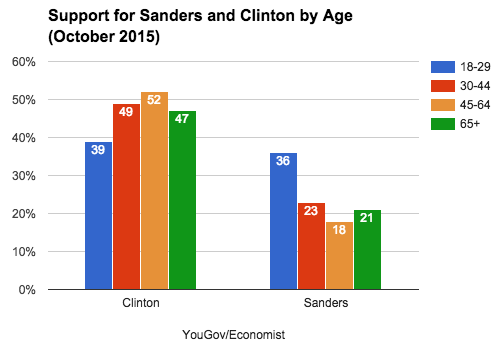The Myth of the Bernie Bro
The notion that Bernie Sanders' supporters are overwhelmingly male isn't borne out by the numbers.

Vermont Sen. Bernie Sanders speaks at Littleton Opera House in Littleton, NH on August 24. Michael Vadon / Flickr
In theory, writing an election take about demographic divides in candidate support is pretty straightforward:
- Identify a demographic divide.
- Provide a plausible theory for the demographic divide.
Because step one is usually pretty easy, most of the punditry action is at step two. But, as Amanda Marcotte’s take earlier this week shows, every so often, punditry is so bad that it doesn’t even manage to get step one right.
The dig clearly stung, as Bernie Sanders immediately went out on Sunday talk shows to deny Clinton’s insinuation that gender played a role in his remarks about “shouting” during the debate.
From the female-heavy crowds that turned out to support Clinton in Iowa, it seems the strategy is working. And not just on older women, either. Girls, from little kids to college aged women, were out in force for Hillary Clinton in Des Moines over the weekend. Moms with daughters, both little girls and teens, were a dominant force in the crowd. Glitter, unicorns, and Disney princess memorabilia was on full display at the Clinton rally. . . .
While both Clinton and Sanders had plenty of young people of all genders turning out, the young people of the Sanders crowd were just as male-dominated as the Clinton crowd was female-dominated. . . .
This contrast continued inside Hy-Vee Hall, where the dinner was held: More young men for Sanders and more young women for Clinton.
Putting aside the question of how much control eight-year-old girls have over what rally they attend, there is an obvious problem with this gender demography point. And that problem is that it’s not reflected in the polling cross-tabs. Although Marcotte insists that she “couldn’t find good polls on gender amongst supporters, much less age,” data for both are readily available on the Internet.
From a YouGov/Economist poll from a couple of weeks ago:

There simply isn’t a gender demographic divide. There is nothing here to theorize about. The take is dead at step one.
Interestingly, however, there is a very significant age divide:

Clinton wins among all groups, but it’s clear that Sanders support is coming from young people. If you wanted to write about demographic divides, it is age and race that matter in the Clinton/Sanders fight. Gender doesn’t even register.
Of course, my points here all assume that election takes are actually about the election. It’s clear in the case of pundits like Marcotte that “election analysis” is just a continuation of their normal personal political blogging. It is a new frame within which they hash out their same themes and grind their same axes, not a genuine effort to figure out what’s going on out there in the vast world of the Democratic electorate. It’s not just her who does this. I would say the majority of election punditry is like this, including on the Right.
This makes sense of course. People get very personally and emotionally committed to their candidates. That bias causes them to perceive the world in a very specific way. It also causes them to feel angered and betrayed by those who support someone else, especially people who they think should be supporting their candidate.
As understandable as this is, it’s also kind of a shame. This is because it actually would be very interesting to see people try to nail down the causes of the real (not imagined) demographic divides. I’d love to read a take that seriously tried to understand why Sanders is managing to pull down so much youth support or why Clinton is managing to attract so many black voters.
But as it stands, when these kinds of pieces get written, the authors aren’t actually trying to figure out what’s going on, but rather trying to make their own freestanding political points through an electoral hook.